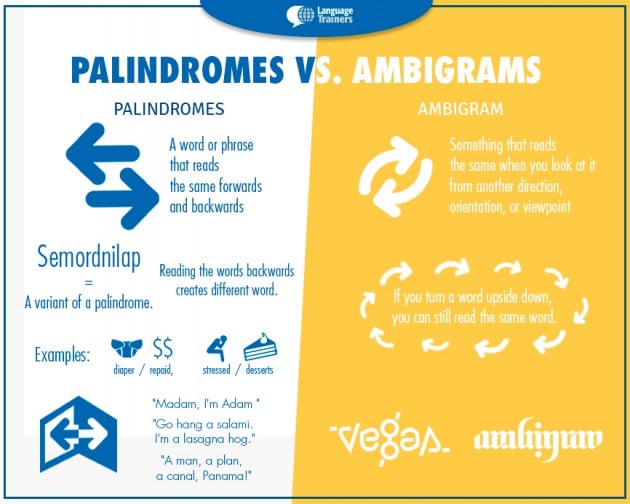Palindromes and Ambigrams
In 1998, comedian Demetri Martin wrote a 224-word poem called “Dammit I’m Mad”. It was written for his Fractal Geometry class while he was studying at Yale. If you look closely, you may notice that the title itself is the same frontwards and backwards. But Martin didn’t just stop with the title. As it turns out, the entire poem is one giant palindrome.
A palindrome is a word, phrase, sequence of numbers, or series of symbols that are read exactly the same from left to right as they are from right to left. This does not normally include punctuation. A famous one a lot of people know is the word ‘racecar’.
We’ve seen them in art, literature, music, religion, and science. Various languages and cultures around the world have used them for both entertainment and spiritual purposes throughout history.
James Joyce coined the longest palindromic English word in his book Ulysses. French novelist George Perec wrote a 5,556 word palindrome called “Le Grand Palindrome”. And English author David Stevens wrote an entire palindromic novel that was over 58,000 words long!
Palindromes have been used in classical music compositions. Composer Anton Webern’s music is known to be notably palindromic due to his interest in symmetries, which were particularly pertinent in the arts of the Renaissance.
We’ve seen palindromes used extensively in the Quran and in many other pieces of Arabic literature.
Molecular biology and other biological structures have also made reference to the word palindrome. But the main connection made in science is to the symmetrical aspect of the term, but ignores the fact that palindromes exist primarily for words.
Make sure you don’t confuse palindromes with semordnilaps (good luck pronouncing that one out loud). A semordnilap is a word that when read backwards is a different word. For example, the reverse of the word ‘stressed’ translates to ‘desserts’. Perhaps a better example is the actual word semordnilap, which in reverse spells out palindromes.
Palindromes and semordnilaps are variations of how words and phrases are read. But we see symmetry everywhere, not just in words and phrases. An ambigram is basically like the artistic equivalent of a palindrome. An ambigram is something that still appears as a coherent word or phrase when viewed from multiple angles. It can either be the same word/phrase or something different. Indeed, while palindromes depend on how they are written, ambigrams depend more on how they are drawn.
There’s a strange and mysterious order to the universe, it seems. We see it everywhere, both in the things we ourselves have created as well as that which exists naturally. Can you think of any other examples?

